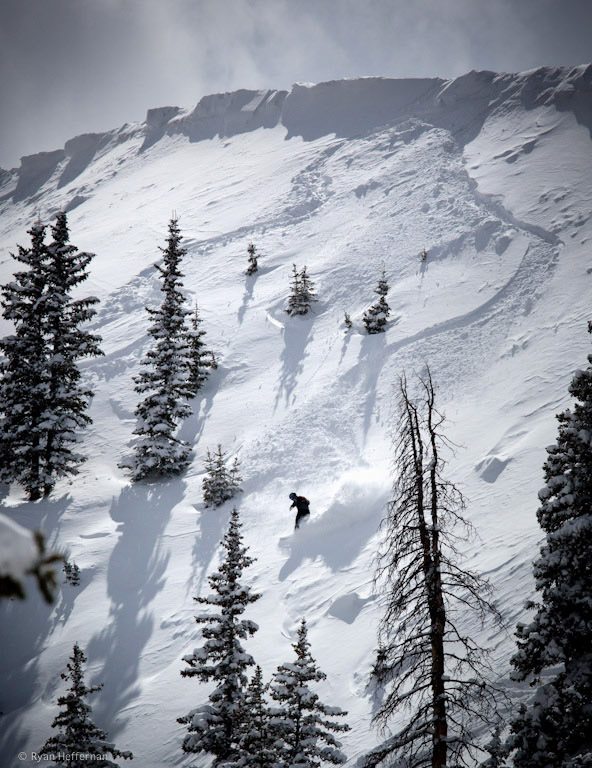I also rode the 136 Surf-Trac board for a couple of days, which has an extra point of contact in the tail and more camber than the 142 S-Camber. This board is made for hardpack—whether on groomers or in the park—and it certainly worked well in those conditions. I felt more stable at speed and was able to hang on to the steep stuff better, but only to a certain point. When things got real steep—Taos steep—the Surf-Trac just didn’t cut it. It chattered and would slide out if I pushed it too hard, like when straight-lining from a steep face onto a groomer.

I never got comfortable on either of the boards at the serious speeds at which I like to ride and that Taos tends to dish out. Both boards are cambered (the 142 S-Camber slightly less so), so they should have had good edge hold, but I think the lack of tail offsets any traction one might get from said camber. Once I really got moving on anything other than a totally smooth groomer or in deep powder, things started to feel scarily unstable.

The lack of tail affected me in the air, too. I felt like I was constantly about to dig my nose on landings. Once again, that normal swing weight was not there, so it took some adjustment to get used to.
Once I compensated though, I took the Surf-Trac into the park. Interestingly, Nativ bills the Surf-Trac as being built for “park shredders,” which seems odd given the board’s huge nose, small tail, and lack of kick. I’m not a huge park guy, but I found that the Surf-Trac spun well and was really playful in the air, though I did wish it had more flexibility to add a little pop (and to add forgiveness on hard sections elsewhere on the mountain).
As the end of the season loomed here at Taos and I’d almost given up on a last powder day, another storm system rolled in. I thought I’d give the 142 S-Camber a shot when things were deep. It turned out to be one of the best decisions I made all season.
The S-Camber lit up in the fluffy stuff. It turned effortlessly, which was especially nice in the trees off Two Bucks. When I opened up in the aprons underneath the chutes off the West Basin, the stiffness of the board worked in my favor and kept me perfectly balanced and floating on my trailing leg. Up in the chutes, the lack of a tail was an advantage, letting me dodge rocks and make speed scrubs in an instant. I’d found where the S-Camber is most at home.

I will say, though, that either Snowsurf board would be easier to learn on than a traditional snowboard. They’re easier to turn and harder to catch a rail because the tail contact is broken, and they work well on lower-angle terrain where edge hold isn’t an issue.
Bottom Line: If you’re used to riding any other snowboard, the S-Camber and Surf-Trac take quite a bit of getting used to. But, as Nate told me, the goal is not for these boards to ride like a conventional snowboard—Snowsurf boards are supposed to be in their own class.
In powder, the S-Camber worked like magic and was both floaty and responsive. If I were going to be riding strictly powder all day, I’d definitely turn to that board. If the conditions were variable at all, however, I’d leave it on the rack.
The Surf-Trac is a different story, with improved stability over the S-Camber. It works well in the park and on groomers. These are not one-board quivers, but if you’re looking for something with unique qualities that is certainly different from what anyone else has on the mountain, check these out.
(Note: The Snowsurfs will be changing significantly for 2012-2013. Nativ will add a longer tail “for increased drive through turns and more control on the steeps,” a redesigned wood core to promote a more flexible feel, and increased side-cut for tighter turning ability.)

So how is this board different from being a shorter burton fish? wouldn’t the extra length in a fish help with the stability issues that you found with this board.
Hi Lance,
I haven’t ridden the Burton Fish but from what I can tell the Fish is supposed to be more like a traditional pow board with a swallow tail (the notched v-shape). You’re only supposed to ride it 3-6 cm shorter than your normal board and they say that you could ride it in the park as well. The Snowsurfs are significantly shorter which I imagine really changes the turning dynamics compared to what you would find with the Fish. I think you’re right, though, the extra length would help with stability issues. Nativ is adding more sidecut and a longer tail next season which should help out with those issues.
Ride it in Japan powder and you won’t believe how much fin it is. So much control and manoeuvrability, especially in the trees. Ive had one for a few years but its one of their original creations, and its still epic.
Riding it anywhere near ice is madness.